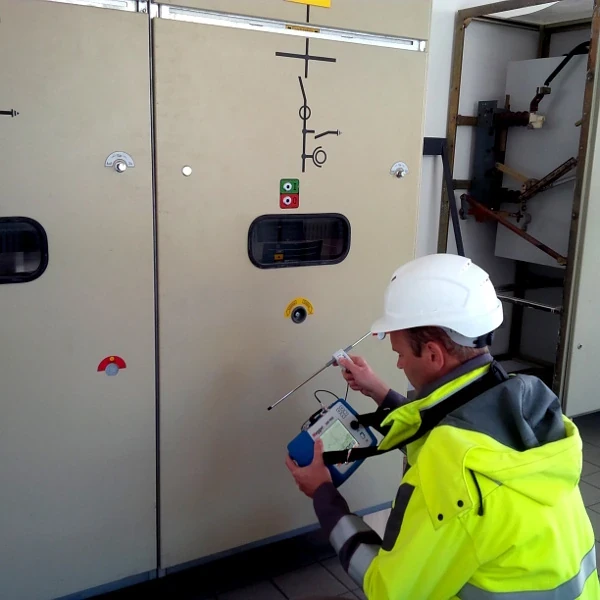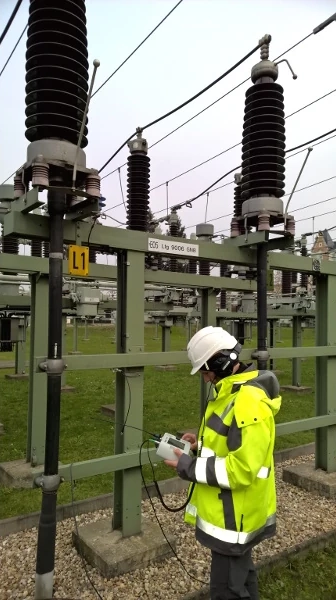Megger UHF PDD Partial Discharge Detector
- Handheld Online PD Substation Surveying System
The Megger UHF PDD Partial Discharge Detector is a powerful handheld tool designed to detect and analyse partial discharge (PD) activity in medium voltage (MV) and high voltage (HV) substations. Component failures in substations can cause dangerous faults, costly equipment damage, and long unplanned outages. The Megger UHF PDD helps engineers and maintenance teams detect developing insulation problems before they escalate into failures, ensuring a safer and more reliable power network.
▶ Megger UHF PD Detector - Why it‘s important for your kit:

Why Choose the Megger UHF PDD?
The Megger UHF PDD provides a non-invasive, online testing solution that allows accurate measurements without taking equipment offline. It captures partial discharge activity in the ultra-high frequency (UHF) range, above common electrical disturbances, making results more reliable. With its phase resolved partial discharge (PRPD) pattern recognition, users can distinguish between harmless corona or surface discharges and more dangerous internal discharges that pose a risk to equipment life.
This level of diagnostic capability is essential for predictive maintenance programmes, helping utilities and industrial operators reduce downtime, increase asset life, and cut unnecessary replacement costs.

Key Features of the Megger UHF PDD
- Non-invasive online PD testing in MV and HV substations
- Dual channel system for comparing two sensors or two phases
- Large 6-inch colour touchscreen for simple, intuitive operation
- Synchronisation with power frequency (internal, mains, or external) for accurate PRPD pattern analysis
- Integrated RF and UHF measurement capabilities in a single device
- Lightweight and portable – only 1.9 kg with over 10 hours of battery life
- Spectrum, time domain and PD level measurements
- Rugged IP65 handheld design with IP67-rated transport case for maximum protection
Applications:
The Megger UHF PDD is ideal for surveying and fault detection in:
- HV assets such as cable end-terminations, surge arresters, voltage transformers, and isolators
- MV switchgear and cable systems using optional TEV and HFCT sensors
- Substations up to 500 kV, when used with the UHF C1 PD coupling sensor
Dual-channel comparison gives engineers the flexibility to analyse different phases or sensor types side by side, ensuring more accurate diagnostics.

↑ Engineer using the Megger UHF PDD Partial Discharge Detector in a utility application
What comes in the standard kit?
- Megger UHF PDD Partial Discharge Detector
- Mains synchronisation sensor
- UHF di-pole antenna
- Charger and BNC cable
- Rugged transport case
Optional extras include HFCT sensors, TEV sensors, and advanced UHF coupling sensors for more detailed HV component testing.
Technical Highlights:
- Frequency range: UHF 150–1000 MHz, RF 100 kHz–70 MHz
- Sensitivity: –90 dBm
- Display: 6” touchscreen, 640 x 480 resolution
- Internal memory: 10 GB
- Power supply: Li-Ion battery, >10 hours operation, 6 hours charging
- Weight: 1.9 kg (device only)
- Operating temperature: –20 °C to +50 °C
- IP rating: IP65 (device), IP67 (transport case)
❓ Frequently Asked Questions (FAQ)
Q1: Can the Megger UHF PDD be used while equipment is live?
A. Yes, the unit is specifically designed for online PD measurements, making it ideal for live substation surveys.
Q2: What makes the UHF method better than other PD detection methods?
A. UHF measurements operate above common electrical noise, ensuring more accurate detection of real PD signals and reducing false positives.
Q3: How long does the battery last?
A. The rechargeable battery provides over 10 hours of continuous operation, allowing for a full day of field testing.
Q4: Is it suitable for both MV and HV equipment?
A. Yes, the Megger UHF PDD supports both medium and high voltage substations, with optional sensors available for a wider range of applications.
The Takeaway
The Megger UHF PDD Partial Discharge Detector is a compact, robust, and highly accurate tool that should be in every maintenance team’s toolkit. With its ability to provide fast, non-invasive diagnostics, it ensures operators can identify insulation problems early, minimise costly downtime, and keep substations running safely and efficiently.